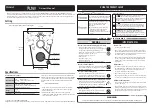
ABEM Terrameter SAS 1000 / SAS 4000
- 4 -
2.1
TERRAMETER SAS 4000 - THE SYSTEM
The Terrameter SAS 4000 system consist of the following components:
•
SAS 4000 instrument with four input channels, including clip-on battery tray
•
External Battery Connector
•
RS 232 cable (with KPT connector to SAS 4000 and DSUB connector to PC)
•
Documentation kit (two sets of Operators Manual, Warranty Registration Card)
•
CD with software
2.2
TERRAMETER SAS 1000 – THE SYSTEM
The Terrameter SAS 1000 system consist of the following components:
•
SAS 1000 instrument with one input channel
•
External Battery Connector
•
RS 232 cable (with KPT connector to SAS 4000 and DSUB connector to PC)
•
Documentation kit (two sets of Operators Manual, Warranty Registration Card)
•
CD with software
2.3
TERRAMETER SAS 1000 / 4000 - GENERAL
The Terrameter SAS 1000 / 4000 can operate in three modes:
•
In the resistivity surveying mode, it comprises a battery powered, deep-penetration
resistivity meter with an output sufficient for a current electrode separation of 2000 meters
under good surveying conditions. Discrimination circuitry and programming separates DC
voltages, self potentials and noise from the incoming signal. The ratio between voltage and
current (V/I) is calculated automatically and displayed in digital form in kiloohms, ohms or
milliohms. If array geometry data is available, apparent resistivity can be displayed. The
overall range thus extends from 0.05 milliohms to 1999 kiloohms.
•
In the Induced Polarization mode the SAS 1000 / 4000 measures the transient voltage
decay in a number of time intervals. The length of the time intervals can be either constant
or increasing with time. The IP effect is thus measured in terms of chargeability [msec
V/V].
•
In the voltage measuring mode, the SAS 1000 / 4000 comprises a self potential instrument
that measures natural DC potentials. The result is displayed in V or mV. Optional non-
polarisable electrodes are available for e.g. self potential surveys.
A useful facility of the Terrameter SAS 1000 / 4000 is its ability to measure in four channels
simultaneously. This implies that as well resistivity and IP measurements as voltage
measurements can be performed up to four times faster. The electrically isolated transmitter
sends out well-defined and regulated signal currents, with a strength up to 1000 mA and a
voltage up to 400 V (limited by the output power 100 W). The receiver discriminates noise
and measures voltages correlated with transmitted signal current (resistivity surveying mode
and IP mode) and also measures uncorrelated DC potentials with the same discrimination and
noise rejection (voltage measuring mode). The microprocessor monitors and controls
operations and calculates results.
In geophysical surveys, the SAS 1000 / 4000 permits natural or induced signals to be
measured at extremely low levels, with excellent penetration and low power consumption.















































